What is happening in China?
That is by far the most important Covid-related question right now. The future of Covid elsewhere might be frustrating, but what is happening in China is potentially a much bigger deal, from disrupting supply chains all the way up to potential loss of the Mandate of Heaven.
I want to emphasize that it is very difficult to know what is going on inside China and my sources for this are not the best. I find the Ukraine war a relative epistemic cakewalk compared to this. So please understand that the alarmist claims from various threads are to be taken with large heapings of salt.
Stocks
One measure that is objective but that I have not previously looked at is the Chinese stock market, which looks like this.
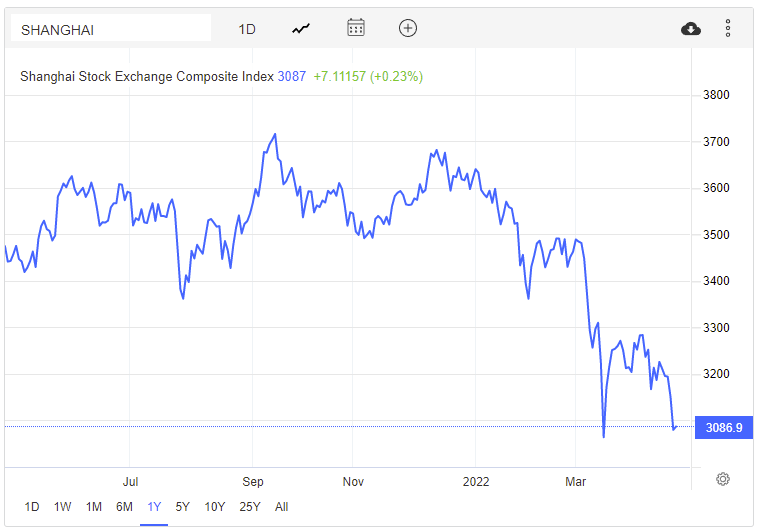
By contrast, here’s the US stock market using the same style graph:

Since the start of March, the US stock market is up while the Chinese stock market is down, approximately +5% vs. -14%. Given that this is long term value, that’s a very large difference. China had been underperforming for the previous year as well, which could be any number of things related or unrelated to Covid.
Cases
The other obvious thing to check, despite its reliability issues, is the official case count. Remember that this is on a log scale. It matches up with previous data – those who understand my model here can look at the graph then skip this section.
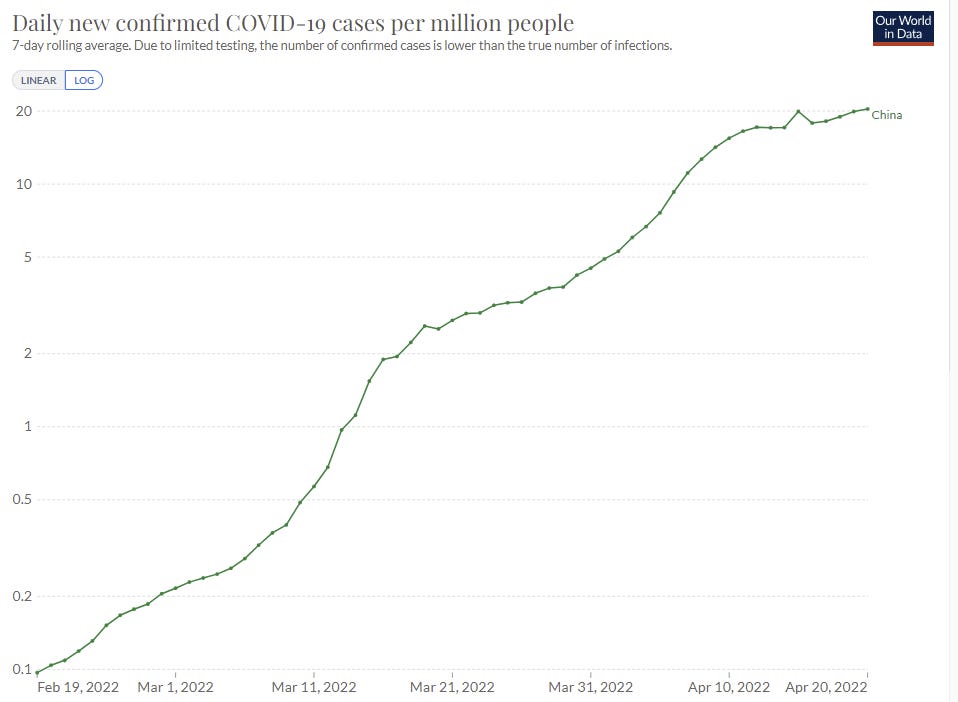
This continues to look a lot like a steady straight line up, from 0.1 cases per million mid-February, a little over two months ago, to about 20 cases per million now. China’s Zero-Covid countermeasures have slowed the growth in percentage terms, and have done extra slowing of growth in the last two weeks, but growth is still positive.
Taken at face value, this is potentially close to the very worst case scenario for China.
The best case scenario is that one can indeed sustain Zero Covid at a price worth paying. We now know this does not apply to China.
The next best scenario is China realizes they cannot maintain Zero Covid, so they use their prevention efforts where and when they are useful. They protect the most vulnerable, and they use countermeasures to flatten the curve when case rates get super high, taking advantage of cultural differences and state capacity in such matters to do so at lower cost than similar actions would require in the West.
Alas, we live in neither of these scenarios.
Instead, China has sufficient (however horribly painful and unsustainable) countermeasures to almost contain the spread. This prevents Xi from realizing or being forced to admit that Zero Covid has failed, and the policy continues. Local officials impose horribly expensive restrictions to avoid becoming the next Shanghai or the next scapegoat, as the short and long term pain piles up, but no one is in position to change course.
Then, when we get closer to the peak in cases, and the time comes that such prevention efforts would save lives, China will have already used much or even most of its state capacity, economic capacity and public goodwill for lockdowns, and will not have such tools fully available. Slowing down case growth to ‘flatten the curve’ only works when you are within a few doublings of the peak. Any efforts spent before that, except insofar as you bought valuable time, are wasted.
Deaths
This is what China is reporting. Note that this isn’t per-million, this is actual individual deaths reported on a daily basis, full stop.

This is also, of course, a joke rather than a plausible lie. There is zero chance these numbers are remotely accurate, even if case data is mostly accurate. What is interesting is that the dam has broken. On April 20, China stopped pretending that this entire Covid wave was somehow entirely without deaths. I am curious what caused that change.
The real number of deaths is far higher. We will never know what it was, but deaths so far will almost certainly be overwhelmed by deaths in the future so it scarcely matters. How many of those get reported depends on many factors.
Shanghai
Shanghai became the reported epicenter of the Chinese pandemic several weeks ago. The vast majority of reported cases take place in Shanghai. The city has been under strict lockdown with tons of tests, yet cases stubbornly refuse to decline. We know that the countermeasures there, despite the high human cost, are not working, even if we don’t know exactly why they are not working.
What is most odd is that those countermeasures are not only not working in absolute but in relative terms. I expected Shanghai to become a smaller percentage of cases over time because it has countermeasures other places do not, yet that did not happen.
There have been some protests, but if anything news of such events has quieted down since peaking about a week ago. Part of a long thread of happenings, this is a perspective from a Chinese state media source on a BBC report on unrest in Shanghai, from 15 April. Original thread is from a very anti-CCP source. Scrolling up in that thread provides a bunch of ‘things are bad and people don’t like it’ anecdotes, but so far control has been maintained and a lid kept on things.
We saw this claim on 17 April, but I did not then see more such claims. Things did not break down a day or two later.
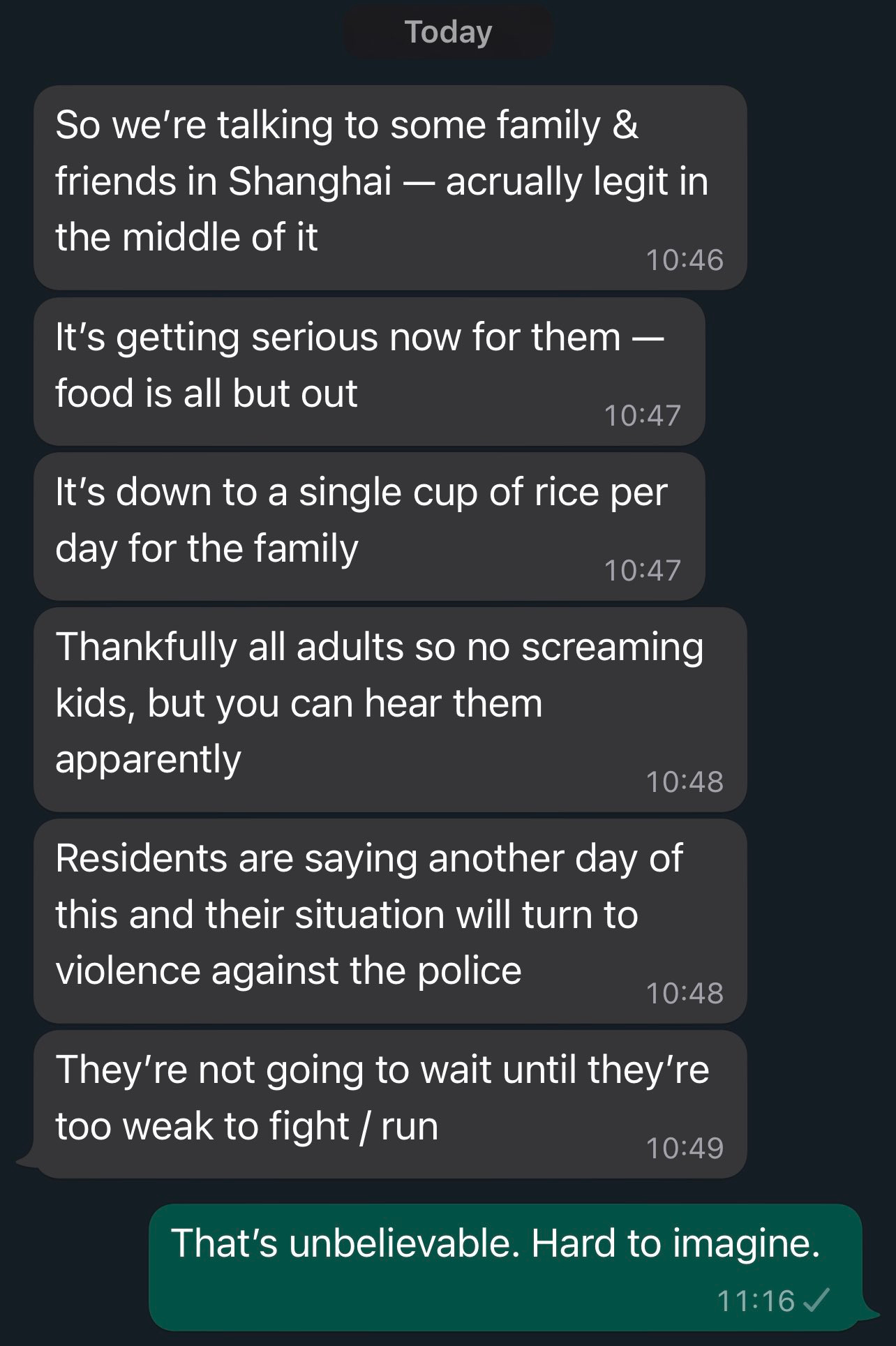
This is a NY Post report from 18 April, from someone stuck in Shanghai. Essentially it is a total lockdown, with tons of Covid tests, yet everyone complies because they see no alternative.
This time around, what is going on is just utterly unbelievable. Despite high vaccination rates and a weaker variant of the virus at large, the restrictions are way tougher this time.
I’ve been locked in my apartment with my wife and kid for more than a month, and I have had to take more than 20 COVID tests during this time. Government health workers appear in white suits every other day, and neighborhood wardens use megaphones to summon everyone outside to take their tests.
There’s more than 1,000 people living in my complex — and everyone complies. Chinese people in general are pretty obedient. Privately, many Chinese friends tell me they don’t like the procedure and lockdown but believe going along with it is the quickest way back to normality.
…
Things have eased off this week, but last week we had serious problems ordering food online and were surviving on government handouts. The lockdown meant most delivery drivers weren’t working. So there was plenty of food, but we couldn’t get our hands on it.
We weren’t alone: My social media were full of angry, sad and bewildered Chinese friends asking where their next meal would come from. In one of the most modern connected cities in the world used to being able to order anything online and have it turn up on their doorstep soon after, this was nothing short of traumatic.
Seeing open criticism of the government was also quite stunning as it’s something that just never happens. It all added up to a surreal atmosphere.
There’s also fear this time around — not of the virus itself but of testing positive. If you do, you’ll be taken away to a makeshift “hospital” where the lights may be on 24/7 and there are no showers. You’ll be isolated from the outside world and not let out until you test negative four or five times.
That matches older reports on the situation in Shanghai. One possibility is that officials are loosening and tightening in response to social unrest and food shortages, to keep things under control, but that having to do so is preventing the lockdown from working. Again, this level of lockdown should be sufficient for the city in question while it continues to see a decline in cases. Failing even on those terms is strange.
These firsthand accounts make it more clear what likely is happening. Shanghai is divided into xiaoqus, complexes with gates that sometimes contain thousands of people. What China did, as I understand it, was lock everyone inside their xiaoqus. Within each one, movement remained free. So lots of people are now locked inside heavily confined spaces, forced to interact with their neighbors who they would usually never interact with the same way I mostly don’t interact with my building here in New York, as that’s the only way they can interact with anyone and more importantly the only practical way to get reasonable supplies of food.
If even one case is found inside the xiaoqu, everyone gets locked down. Which is a penalty for being late problem – you’re already fully screwed if anyone in the group has Covid, so a lot of people likely act as if no one in the xiaoqu has Covid. Which means the total amount of spread ends up not obviously being lower than before/without the lockdown, if there is any method of infections crossing between xiaoqus, which is likely provided by testing and food deliveries.
China at least makes a plausible case that it has a ‘whatever it takes’ style approach to the situation, but that is not combined with careful scientific modeling of the situation. Quite the opposite.
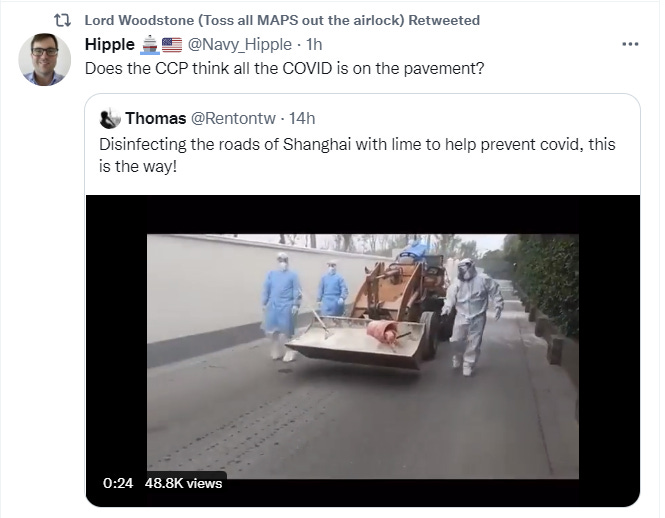
Thus it makes perfect sense that they may have cracked down on many levels that don’t matter while leaving vulnerabilities that mean the situation keeps getting worse anyway. A lot of the pain being inflicted is accomplishing nothing. Consider that no one is spending any time outside.
The Port of Shanghai has a rapidly increasing backlog. The top image is quite the Rorschach test. At least twice I thought I kind of saw a dragon. The second is less subtle.
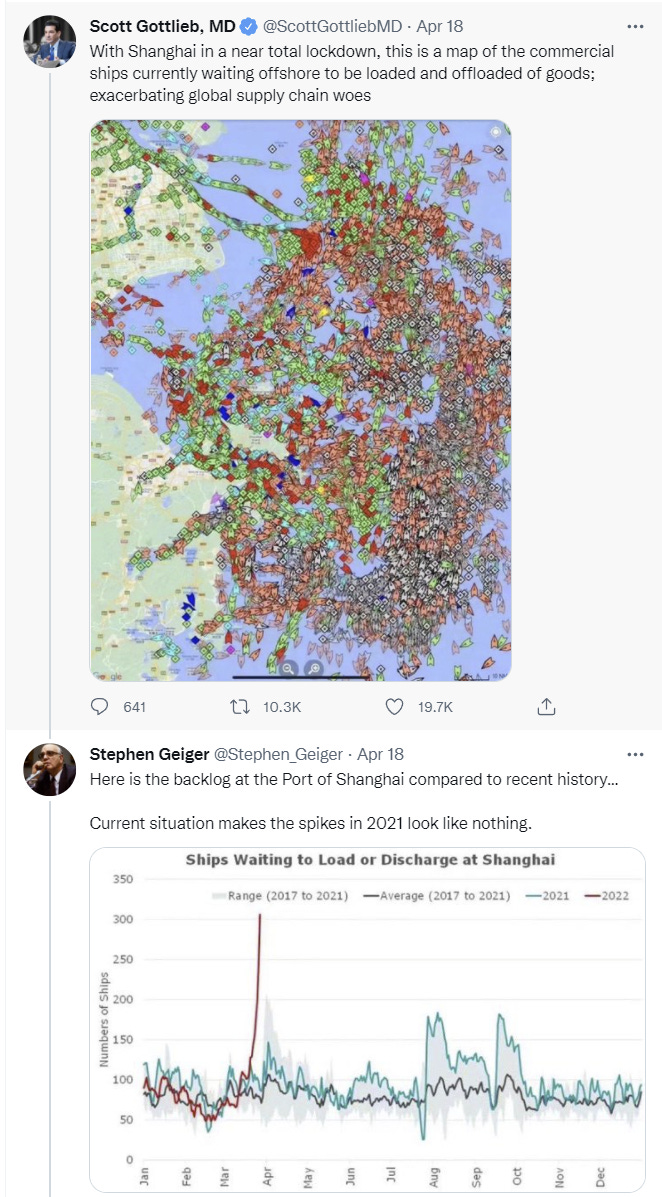
Shanghai is only one port, but it is an important one. The problem isn’t confined to Shanghai, but it would be a big deal even if it were, although it sounds like for now things have not spiraled too far out of control.

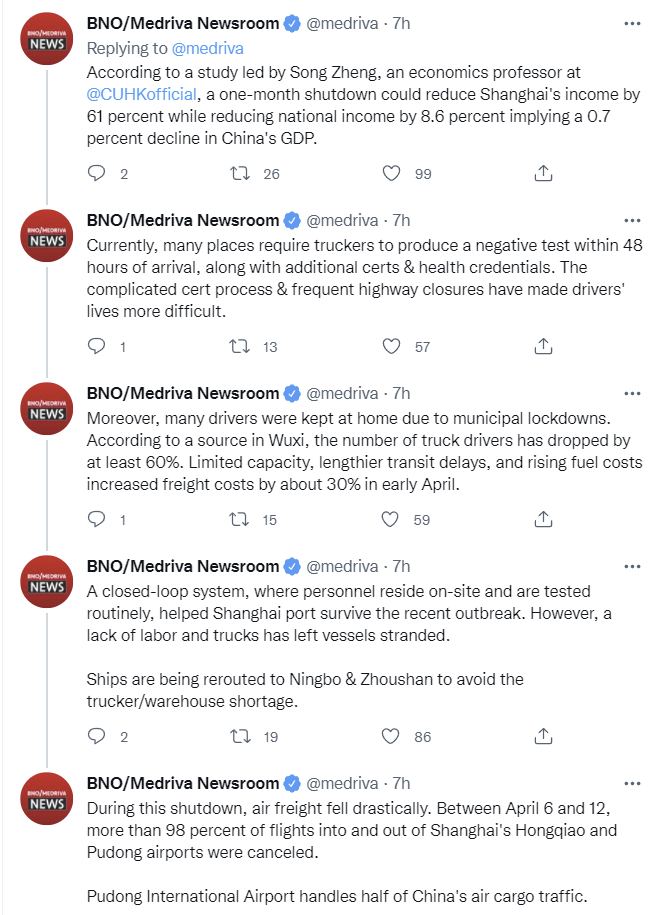
None of that is good, but it mostly (the airport question is scary depending on how much rerouting is possible) sounds survivable on its own at least for a while. It seems increasingly likely May will not be a productive month for Shanghai, causing increasing ripple effects.
Residents of some areas of the city are now being asked to relocate to a quarantine facility outside of the city. This seems like an escalation that could potentially make the situation a lot more volatile. By all accounts things are tightening further, which is indeed what one has to do if progress is not being made. I have little faith that they will choose the right tightening to do.
When I last posted on the situation in Shanghai I was criticized for using the term ‘starvation’ when no one was outright dying for lack of food. I don’t think we know whether that is happening – it sounds like if someone does not understand how to navigate the system, there could be severe issues getting enough food to eat, things have gone on long enough now that full starvation is potentially in play, and I do not think the safety valves to prevent this from happening seem all that reliable. Still, if it was widespread, we would know about it.
So I want to clarify that in terms of what has happened so far ‘starvation’ refers mostly to people getting inadequate calories and not to danger of imminent death. The thing is, that could change. Already in Woodstone’s thread below there is a specific claim of someone starving to death. There is nothing inherent in the dynamics involved that would confidently prevent the worst from happening. Certainly there is precedent.
China Overall
The bigger food security question is longer term, and combines with worldwide concerns about lack of access to fertilizer potentially depressing crop yields. If farmers are unable to plant their crops in many parts of China, or have to plant at non-ideal times or under sub-optimal conditions, and the outside market is already dangerously tight, that could be a very, very bad combination.
We have reports of farmers being barred by Covid restrictions from plowing their fields, but it is hard to know how widespread is this issue. The central government was reportedly trying to stop this from happening, but the local incentives push in such directions.
Cases not going up faster outside Shanghai, while Shanghai tries so hard yet fails to contain the outbreak, indicates some dramatic actions must be going on throughout much of China.
Here’s Jon Stokes giving a grim perspective on potential for food shortages and supply chain issues (there’s some talk about Ukraine there too, which I didn’t copy over). He tends to offer grim perspectives and to pay a lot of attention to potential very bad outcomes, so adjust for that, and he makes it clear (very much to his credit) his uncertainty over how bad things are, but I am confident he’s being concerned for reasons.


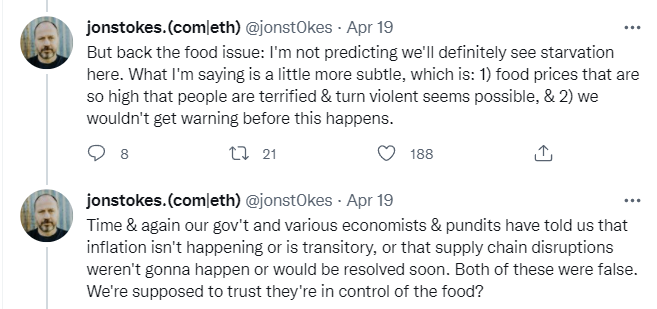


Outside of China, this thread about various food processing plants blowing up is wild. Again, I don’t know what to make of it, could still be law of large numbers. And a few years ago, I would have thought very little about such concerns.
Yet now I realize that I strongly agree with Jon that, while there may or may not be a huge problem coming our way and things (at least in America) will probably be fine, if there was a huge problem we cannot assume the Responsible Authorities would notice. Nor should we assume the market would come anything close to fully noticing either. There are no Responsible Authorities and adults out there, it’s only us.
Here’s the most extreme ‘China is screwed’ perspective I have seen so far. I asked on Twitter whether anyone could speak to its accuracy, and didn’t get much of anything either way. Lord Woodstone did link to a post documenting the sources.
My take is that the claims below are cherry-picked and framed to be seen as maximally alarming, but that even so there is a lot to be alarmed about.
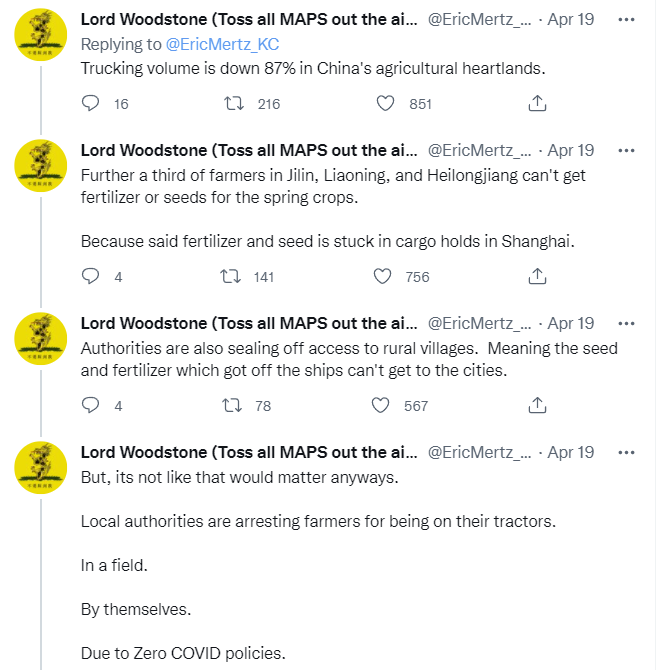
A key point for such problems is that the Chinese mostly consume fresh food, which is good for their health but makes them more vulnerable to supply chain disruptions. It is a lot easier for the food to go to waste.


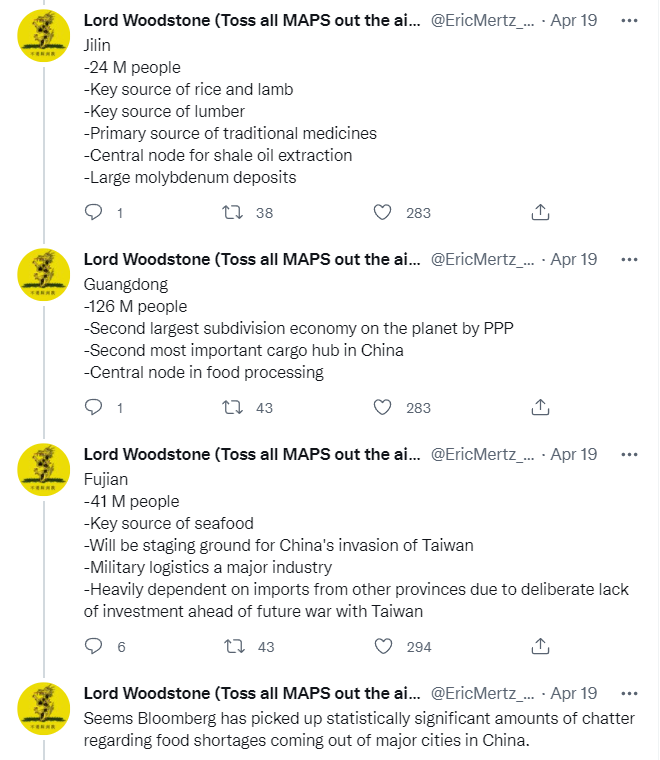
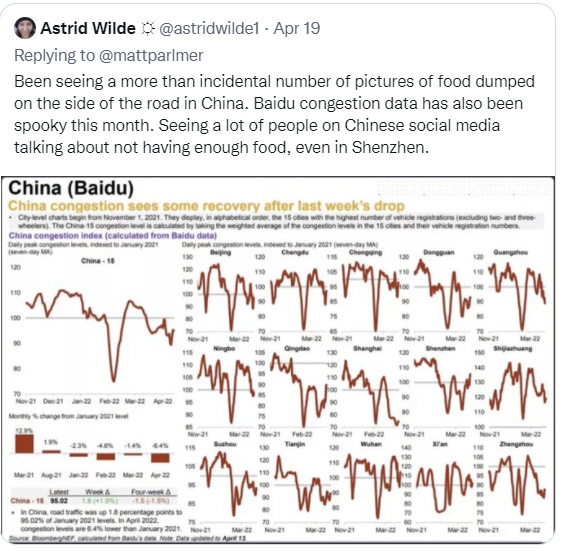

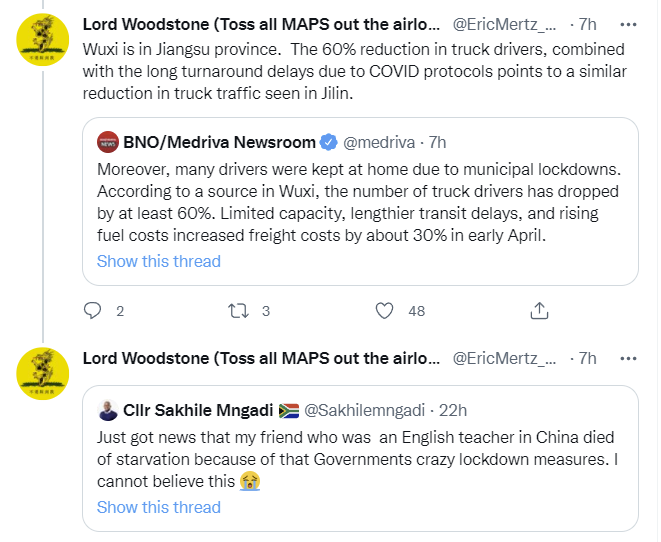
There is also a link to a follow-up post on water. The sources documenting the thread above are listed here.

“The best case scenario is that one can indeed sustain Zero Covid at a price worth paying. We now know this does not apply to China.”
I think it was pretty clear soon after Omicron appeared that this did not apply to China, or anywhere else. What would a successful zero-covid campaign look like? Even with strict border controls which are very expensive themselves, omicron will get in every couple months, meaning constant rolling lockdowns forever (or until a new vaccine with sterilizing immunity is found and administered to enough Chinese and/or the world).
1) Lord Woodstone thread: adding up the population numbers gives 787 M i.e. mostly this is a list of what provinces China has rather than information. Likewise everything is a “key” or “central” node of this-and-that, often in nonsensical ways. Shandong of 101 M is “heavily dependent on” Korean&Japanese tourism (their total population being only ~200 M) ?? Everything is simultaneously very agricultural *and* heavy-industrial, plus sometimes also high-tech/pharma. (I mean, in what is today the developed world, agriculture’s share of GDP&employment&stuff went from something like 80% to 1-5% over the 1850-2000 period, which China tries to speedrun in 50 years.) He tries to divide more than 100% importance mass between things.
2) Doesn’t Chinese freight mostly move on rails?
3) I’m surprised that the Chinese government hasn’t found/picked/faked a villain/scapegoat to take the blame for the failure of covid-zero. (I was also surprised the gas pipelines kept running while Russia and Ukraine fought around them. I was agnostic as to which would blow up or at least
turn it off — in the previous decade, both have, plus IIRC Russia has in the past blown up a pipeline in Turkmenistan(?) to get out of a contract to buy their product because world market prices have dropped too much in the meantime.)
Baader-Meinhof food processing plants:
4) Grain elevators (silos) blowing up is the #1 favorite example of dust explosion people, exactly because unlike saw- and coal dust, people don’t have the immediate association that sugar, flour, or cereal debris would burn.
5) For a while, Sal Mercogliano had a bit where he listed a few major shipping accidents of the week. Initially it was astonishing/alarming that he had so much material to pick from. (I don’t actually recommend the channel, some individual videos are decent for introduction but are highly redundant with his other videos; probably the most valuable piece of information was that he recommended one of the trio at https://transportgeography.org/, probably port economics.)
1) I agree that the way this is presented is weird. It does come off as a list of what provinces China has. One conclusion you might draw is that a majority of China (population weighted or GDP weighted) has closed its highways. If that’s true, then they should have said it directly. That would get the point across much more effectively.
I am not surprised that many provinces are both agricultural centers and industrial centers. In the US, California could be described that way, along with a lot of the Midwest and parts of the South. China still has about a quarter of its workforce in agriculture: https://www.statista.com/statistics/270327/distribution-of-the-workforce-across-economic-sectors-in-china/ . The provinces with the most people are likely to be the major centers of both agriculture and industry. I agree that it comes off weird and feels like the sum is over 100%, but it might not be inaccurate.
2) It doesn’t look like it: https://www.statista.com/statistics/1088689/china-modal-split-of-freight-transport/ . Even if it were true, there’s a last mile problem. Railroads don’t extend to every farm, so you need trucks to carry the seed & fertilizer from the railroad depot to the farms themselves.
I can’t believe I’m saying this, but for nuanced takes on China I always go to one particular Sexy Cyborg.
Re: starvation in Shanghai, she had choice words: https://twitter.com/RealSexyCyborg/status/1517304005059178496
Re: real number of deaths: https://twitter.com/RealSexyCyborg/status/1516343323035795456
Re: Covid zero approach in China in general: https://twitter.com/RealSexyCyborg/status/1514818345689776143
Unrelated, but I recommend this recent take about Traditional Chinese Medicine: https://twitter.com/RealSexyCyborg/status/1516628661557817350
Also unrelated, but I absolutely love her ongoing crusade against platforms confusing her look with porn: https://twitter.com/RealSexyCyborg/status/1514956944779350025
> Re: Covid zero approach in China in general:
Didn’t make me convinced. Australia also practices zero covid but have admitted defeat and also realized that with good vaccination coverage especially for elderly it doesn’t matter anymore. Why cannot China do the same?
> Unrelated, but I recommend this recent take about Traditional Chinese Medicine:
This is also non-controversial. It is well known that the value of complementary medicine is mostly in patient-doctor relationship (taking time to talk to patient with empathy etc. for which highly paid western doctors don’t have time) and not the traditional medicines itself. Of course, how exactly the align both systems is not a solved problem even in the west. Good for her followers but but she didn’t tell anything new.
A new Danish RCT review study is out, which looks at total mortality differences between the vaxxed and unvaxxed, not just Covid deaths.
Vaccines can have broad heterologous effects on the immune system. These effects can lead to additional protection or increasing susceptibility to unrelated infections or even other non-infectious immune mediated diseases.
mRNA vaccines (Moderna, Pfizer) had a Relative Risk (RR) of 1.03, meaning they were not associated with a mortality improvement. Worse cardiovascular mortality compensated for improved Covid-19 mortality. (RR 95% CI=0.63-1.71)
Vector vaccines (J&J, AstraZeneca) had a RR of 0.37, so were associated with a significant improvement in overall mortality. (RR 95% CI=0.19-0.70)
If this turns out to be correct, it would be pretty devastating for the whole idea of vaccine mandates for health populations, no?
https://papers.ssrn.com/sol3/papers.cfm?abstract_id=4072489
If you tell me you think they actually properly controlled for who chose to get vaccinated I’ll look, I guess, but I don’t even know how you do that in theory in a way that makes me trust this.
Also, RR of 0.37 on overall mortality? WTFBBQ4TW or something? That would be the biggest ‘shout it from the rooftops’ of all time even at the 0.70 high end, yet somehow I don’t sense you taking that result seriously any more than I do.
@TheZvi AFAIK they actually did properly control for who “chose to get vaccinated”, because no-one in the studies made that choice – all source RCT studies were properly randomized with a vaccine and a placebo arm.
I’m honestly not sure what to think of the results, but at first sight their methodology looks legit.
OK, I gotta look if only to see how they got permission to do that…
Huh, weird. But with only 30 vs 16 deaths it’s very small numbers so a lot of noise.
Even smaller numbers really. Non Covid, non accident is just 8 vs 16 in adeno trials. 5 cardiovascular in placebo vs. 0 in vaccine arm. They calculate p=0.046 for this. Somewhat intriguing, but not going to be surprised if fails to replicate
IANAS (I Am Not A Statistician) but shouldn’t we look at the 95% Confidence Interval to determine if the numbers really are too small? For example, the original Pfizer study’s secondary endpoint of “severe covid” had a CI of over 100%, essentially making the result meaningless. There, the numbers really were too small, aka the study was underpowered for its endpoint.
In this study, the CIs appear to be narrow enough for some meaningful conclusions,no?
For ‘noise’ in ~ random numbers you can estimate the ‘error’ as sqrt(N), where N is the number (and sqrt is the square root).. this is mostly for something like flipping a coin. The one group was near the expected fatality rate. Mostly what the study says is that covid is not that deadly.
Pingback: Ukraine Post #11: Longer Term Predictions | Don't Worry About the Vase
In unrelated news, “garbage in, garbage out” covid modellers are at it again, and amplified in mainstream Canadian media:
“Unvaccinated disproportionately risk safety of those vaccinated against COVID-19, study shows”
https://www.theglobeandmail.com/canada/article-unvaccinated-covid-risk-for-vaccinated-canada/
where “study” means the published results of a theoretical model.
> The city has been under strict lockdown with tons of tests, yet cases stubbornly refuse to decline. We know that the countermeasures there, despite the high human cost, are not working, even if we don’t know exactly why they are not working.
It seems important to note that cases *are* declining in Shanghai. The single-day peak was 27.7K on April 13, and the 7-day average peak was about 25K on April 14. Cases have been declining fairly steadily since then, with the 7-day average for April 25 being 19.4K.
The reason that Shanghai makes up an increasing percentage of all Chinese cases is that cases in Jilin are falling even faster; the 7-day average was 3K on April 7, ~900 on April 14, and ~300 on April 25. (Jilin is/was also under lockdown.)
Cases outside of Jilin and Shanghai have been steady at 500-600 per day since the beginning of April, with no province having more than 100 or so.
Source: I’ve been manually copying numbers from here into a spreadsheet: http://www.nhc.gov.cn/xcs/yqtb/list_gzbd.shtml
I don’t know what Our World in Data uses for its data source – I used to think it was basically correct, but it seems weirdly off in different ways (apparent lags, etc.).
Side note: Complete speculation but maybe the government was waiting for cases to peak before reporting any deaths? There would be some kind of logic to that, and the timing lines up – cases peaked around April 14, and the first deaths were reported on April 18 (for April 17).